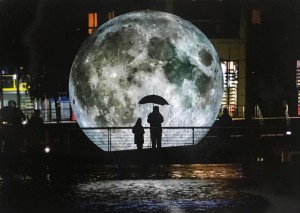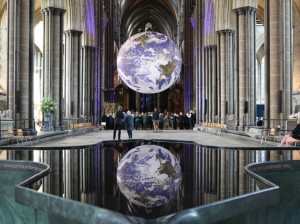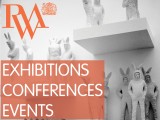Bristol artist Luke Jerram’s touring exhibition of a massive Moon is this weekend marking the 50th anniversary of the Apollo 11 lunar landing as his latest thought-provoking work – a giant Earth – continues its tour.
‘Museum of the Moon’ is circling the globe in a tribute to the Apollo mission, visiting arts, science and cultural venues, including the Commonwealth Games in Australia, displays at five cities of India with the British Council and at Aarhus in Denmark for the European Capital of Culture. 
Seven metres in diameter, the internally lit sphere features detailed imagery of the moon’s surface from Nasa – each centimetre of the artwork representing about 5km of the moon.
Meanwhile, Luke has come down to earth for his latest project. Also 7m in diameter, Gaia features detailed NASA imagery of the Earth’s surface. The artwork provides the opportunity to see the planet on this scale, floating in three-dimensions.
The installation aims to create a sense of the ’overview effect’, which was first described by author Frank White in 1987. Common features of the experience for astronauts were a feeling of awe for the planet, a profound understanding of the interconnection of all life, and a renewed sense of responsibility for taking care of the environment.
BAFTA award-winning composer Dan Jones has created surround sound compositions for both works. In Greek mythology Gaia is the personification of the Earth.
Bristol has been the inspiration behind much of Luke Jerram’s work and has also led to collaborations with coty-based companies such as Cameron Balloons, which put its expertise into creating the ‘moons’ – there several Museums of the Moon currently on display around the world.
He said: “The idea came from living in Bristol. Bristol’s got the second highest tidal range in Europe. There’s a 13-metre gap between high and low tide – and it’s the moon that’s making that happen.”
For the actual 50th anniversary of the moon landing this weekend, the installation is on display in the Houston Museum of Natural Sciences in the US, the Canadian Museum of Natural Sciences in Ottawa and in the railway station in Lille, France. 
Here in the UK, there are several installation’s touring. The Museum of the Moon can be seen at various locations, including at the Natural History Museum in London this weekend through until October. Some have included churches and some visitors have laid down on the floor to look up at it.
In Bristol, Luke Jerram is known for a number of thought-provoking pieces, including installing a giant waterslide down the city’s steepest street, Park Street, back in 2014, which received world-wide coverage.
Another commission was to create a sound wave glass sculpture as the centre piece of the new extension of Bristol’s world-class music venue, St George’s when it opened in 2017.
Gaia will be displayed in Bristol – at the University of Bristol’s Wills Building – between August 15 – 18.
The artwork is 1.8m times smaller than the real Earth with each centimetre describing 18km of the Earth’s surface. By standing 211m away from the artwork, the public will be able to see the Earth as it appears from the moon.
Over its lifetime, Gaia will be presented in a number of different ways both indoors and outdoors. Whether it is presented in a museum, science centre or parkland, the experience and interpretation of the artwork will change.
Unlike the Moon, which we have been gazing at for millennia, the first-time humankind got to see the Earth in its entirety as a blue marble floating in space was in 1972 with NASA’s Apollo 17 mission. At this moment, our perception and understanding of our planet changed forever. Hanging in the black emptiness of space the Earth seems isolated, a precious and fragile island of life. From a distance, the Earth is just a pale blue dot.
The artwork is 1.8m times smaller than the real Earth with each centimetre describing 18km of the Earth’s surface. By standing 211m away from the artwork, the public will be able to see the Earth as it appears from the moon.
Over its lifetime, Gaia will be presented in a number of different ways both indoors and outdoors. Whether it is presented in a museum, science centre or parkland, the experience and interpretation of the artwork will change.
Unlike the Moon, which we have been gazing at for millennia, the first-time humankind got to see the Earth in its entirety as a blue marble floating in space was in 1972 with NASA’s Apollo 17 mission. At this moment, our perception and understanding of our planet changed forever. Hanging in the black emptiness of space the Earth seems isolated, a precious and fragile island of life. From a distance, the Earth is just a pale blue dot.
Museum of the Moon image courtesy of Luke Jerram





























